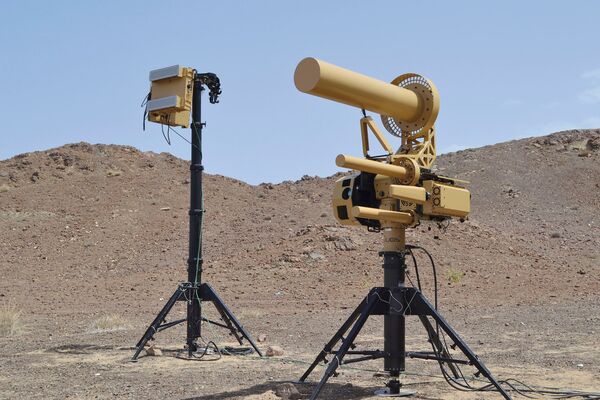- About
- Intara
- Capabilities
- Advisory
- Resources
- News
- Store
Ukraine conflict: Ukrainian military using UK C-UAV system
13 July 2023
by Olivia Savage


AUDS, a C-UAV system capable of detecting, tracking, and disrupting small UAVs, is being used by the Ukrainian military (library picture). (Blighter Surveillance Systems)
The Ukrainian military appears to be fielding a UK-developed counter-unmanned aerial vehicle (C-UAV) system.
Imagery posted on Twitter on 12 July closely resembles components of the Anti-UAV Defence System (AUDS) produced by UK companies Chess Dynamics, Blighter Surveillance Systems, and Enterprise Control Systems (ECS).
AUDS is designed to detect, track, classify, and disrupt small UAVs, and is equipped with Blighter Surveillance Systems A400 series air security radar, Chess Dynamics' Hawkeye Deployable System (DS) and electro-optical (EO) video tracker for tracking and classifying targets, and ECS's smart radio frequency (RF) inhibitor.
The A400 system is an electronic scanning micro-Doppler radar operating in the Ku-band and has a maximum detection range of 8 km, while the RF inhibitor can interfere with UAV command channels covering the GNSS 433 MHz, 815 MHz, and 2.4 GHz frequency ranges.
The integrated solution is available in three configurations – a portable platform for rooftop installation; a deployable option for forward-operating bases; and a fixed system for critical infrastructure. It is not clear which configuration the Ukrainian military is using.
Singapore attributes F-16 crash to ‘rare' gyroscopic failure
20 May 2024
by Akhil Kadidal & Raghuraman C S


The crash of an RSAF F-16 on 8 May shortly after take-off has been attributed to an unusual gyroscopic malfunction. While the variant involved in the crash is not known, it is likely the single-seat ‘C' version (as depicted in this 2016 file photo) was involved. (Roslan Rahman/AFP via Getty Images)
A Republic of Singapore Air Force (RSAF) Lockheed Martin F-16, which crashed on 8 May, was found to have suffered simultaneous gyroscopic failure soon after take-off, according to the Singapore Ministry of Defence (MINDEF).
MINDEF said in a statement that the F-16 crashed on 8 May soon after it took off from Tengah Air Base. A joint RSAF-Lockheed Martin investigation has determined that the aircraft's pitch rate gyroscopes are to blame, MINDEF added on 18 May.
“The flight data recorder recovered from the crashed F-16 showed that its pitch rate gyroscopes gave erroneous inputs to the flight control computer (FLCC),” MINDEF said. “This led to the pilot being unable to control the plane at take-off.”
Poland completes receipt of Turkish UAVs
17 May 2024
by Gareth Jennings


Poland now has all 24 of the TB2 UAVs it ordered from Türkiye, operating them across four systems based at the 12th Unmanned Aerial Vehicle Base at Mirosławiec. (Polish MND)
Poland has received the last of 24 Baykar Bayraktar TB2 armed unmanned aerial vehicles (UAVs) from Türkiye.
The Polish Armaments Agency (AA) announced the milestone on 16 May, saying that the last four unmanned aircraft systems (UASs), each comprising six UAVs, had been received into the 12th Unmanned Aerial Vehicle Base at Mirosławiec on the same day.
“The Secretary of State in the Ministry of National Defense, Paweł Bejda, together with representatives of the Polish Armed Forces, took part in the ceremony of completing the delivery of the last, fourth set of the Bayraktar TB2 unmanned reconnaissance and strike system,” the AA said.
Edge unveils Hunter 5 loitering munition prototype in test video
17 May 2024
by Jeremy Binnie


The Hunter 5 prototype before its first test flight at the X Range. (Edge Group)
The United Arab Emirates' (UAE's) Edge Group has updated the product page for its Hunter 5 unmanned aerial vehicle (UAV) with a video showing its first test flight.
The video said the flight took place in November 2023 at the company's X Range testing facility on Abu al Abyad island. It showed a prototype fitted with fixed undercarriage and non-folding wings, having its two-cylinder petrol engine manually started before it took off and flew around the range's runway.
The promotional image of the Hunter 5 on the Edge website shows it with folding wings, no undercarriage, and a probable rocket booster for launching it from a rail or canister.
The Ukrainian military appears to be fielding a UK-developed counter-unmanned aerial vehicle (C-UAV)...
Latest Podcasts
The value of OSINT for intelligence sharing
In this episode Harry Kemsley and Sean Corbett are joined by Phil Ritcheson Ph.D. to discuss why intelligence sharing is now more important than ever. They discuss the growing need for allied and partnership and how by using open sources facilit...
Listen nowJanes Case Studies
Using Janes Intara to build a common intelligence picture: Russian build up on the Ukrainian border
View Case StudyNews Categories
 Air Details
Air Details